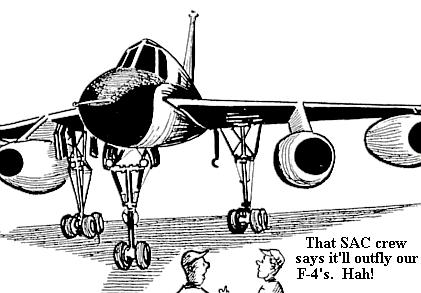Showing Our Stuff
by Phil RoweIt was too much temptation for my pilot to resist. Those F-4 jocks made taunts about how ungainly our delta-winged bomber looked, with its long spindly landing gear and those small-tired trucks. It looked like a mosquito, standing out there on the Kelly Field flight line, especially without the centerline bomb pod attached.
My pilot just had to show those guys what a real airplane could do. The supersonic, Mach-2 B-58 Hustler was indeed a REAL airplane. With four J79 jet engines blazing away in full afterburner, it could out-accelerate, out-run and simply leave most fighters in its dust. Even the hottest jet fighter had but one chance for an intercept against the Hustler. If it missed that one, the bomber's greater fuel capacity would run the fighter out of gas in just minutes.
The two F-4 pilots watched as we left Base Operations and headed for our plane, not realizing that we were about to make a test flight of an extremely light-weight bird. The airplane had just complete a major overhaul by the folks at the depot repair facility. Every few thousand hours, Air Force planes are taken to depots for inspection-and-repair-as-necessary (IRAN), where skilled technicians practically dismantle the entire aircraft to check for structural cracks and signs of potential problems. We wondered how they ever managed to put the birds back together again. And now that ours was ready, we were about to test fly it to be sure everything worked.
Because we were loaded with just a little fuel, enough for a two-hour test hop, we could have made our take-off without using the afterburners. But not this time. My pilot was determined to show those fighter jocks what our ungainly looking, four-engine jet bomber could do.

We lined up at the south end of runway 33, as close to the fence as we could. At our modest weight, about 100,000 pounds, we would be airborne in just 6000 feet. Good. That would put us just about even with Base Operations, where our taunting audience would be watching.
Full afterburner, on those four roaring jet engines, made us practically leap down the runway. At 210 knots we achieved rotation speed. The nose lifted up .. up, up and to a nearly vertical climb. My pilot stood that bird on its tail and we zoomed skyward. Before we reached the end of the 11,500 foot runway we had the landing gear up, and the bird fully configured for maximum performance climb.
The boys on the ground must have had their jaws hanging down in disbelief. We were quickly at 10,000 feet, burners still roaring and spewing out flame, when my pilot did a series of rolls. That would show 'em.
Well, it may have shown the fighter jocks that our B-58 was indeed a hot performer, but it didn't do our avionics equipment much good.
Our navigator was pretty upset to discover that the abrupt take-off and the rapid rolls in the climb had tumbled his gyro platforms. The radar and the inertial navigation system were both out of alignment. It was a good thing that we were in clear weather, where our pilot could fly by visual horizon cues of which way was up. Had we done that in the clouds it could have been a disaster.
It took twenty minutes of straight and level flying for the navigator to re-align his gyro platform and get the system into its normal configuration. The B-58, while certainly a hot performer, was never intended to do acrobatics. It was really a one-"g" airplane.
On reflection, showing off for those F-4 pilots may have made our own jet jockey feel superior, but it was a dumb thing to do. It's a good thing that there weren't any major discrepancies in how the bird was re-assembled by the depot technicians. Over-stressing the airframe and the bird's navigational systems just was not a smart thing to do.
But, it felt sooo good.